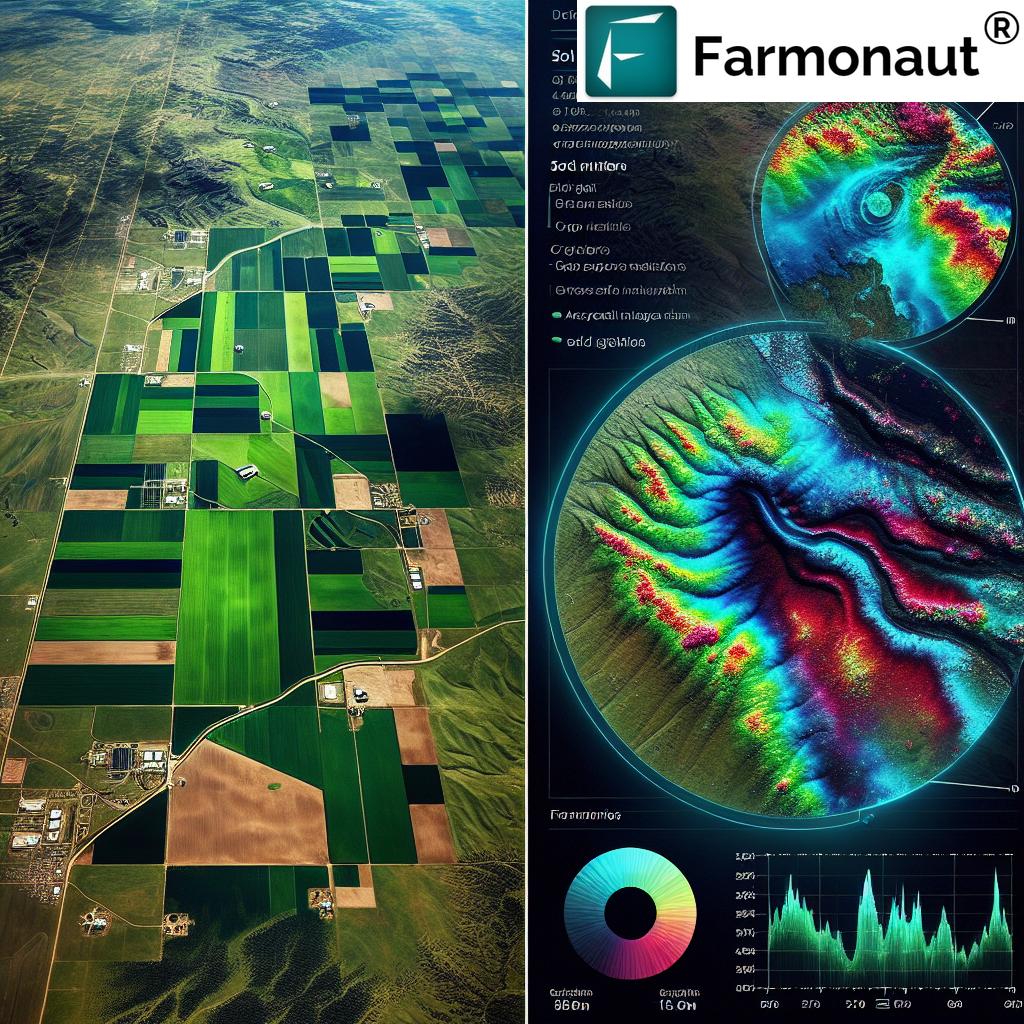Florida Farmworker Who Suffered Heat Strokes: Safety Tips
“Nearly 80% of Florida farmworkers report symptoms of heat stress during peak summer months.”
“Heat-related illnesses cause over 200 agricultural worker deaths annually in the U.S., with Florida among the highest-risk states.”
Table of Contents
- Introduction: Florida Farmworkers and Heat-Related Illnesses
- Florida Farmworkers Health Risks: Understanding the Impact of Extreme Temperatures
- Heat-Related Illnesses in Agriculture: Causes, Symptoms, and Prevalence
- Contributing Factors to Heat-Related Illnesses Among Florida Farmworkers
- Top Safety Tips: Strategies for Protecting Farmworkers from Extreme Heat
- Leveraging Farmonaut Technology for Worker Safety and Sustainability
- Heat-Related Illness Risks and Safety Strategies Table
- Regulatory Landscape: Agricultural Worker Safety Regulations in Florida and the U.S.
- Advocacy and Worker Protections: Current Challenges and Future Directions
- Frequently Asked Questions (FAQ)
- Conclusion: Building a Safer, Sustainable Florida Agriculture Sector
Introduction: Florida Farmworkers and Heat-Related Illnesses
Florida’s agricultural sector is a cornerstone of the state economy, with over 2 million workers—including a vast population of dedicated farmworkers—playing a pivotal role in cultivating and harvesting a diverse array of crops. Our tropical and subtropical climate delivers unique advantages for farming but also brings pronounced health risks due to extreme temperatures and high humidity. These conditions compound the challenges of already demanding work and leave Florida’s farmworker community particularly vulnerable to the dangers of heat-related illnesses in agriculture, notably heat stroke and related conditions.
In recent years, research and tragic news stories have brought the gravity of this issue to the forefront. We’ve seen incidents like the December 2023 death of a farmworker at Alico Farms in Arcadia, Florida, and studies revealing that more than half of farmworkers are already dehydrated before their shift begins. Tackling this widespread yet often underestimated risk requires a proactive approach—rooted in awareness, training, and implementation of robust preventive measures.
In this comprehensive guide, we’ll explore the prevalence and impact of heat-related illnesses among Florida’s agricultural workers. We’ll identify key contributing factors, outline actionable safety tips, examine the regulatory landscape, and demonstrate how innovative agricultural technologies like Farmonaut can support sustainable practices and improve worker safety in Florida agriculture. Let’s begin by understanding the risks we all need to address together.
Florida Farmworkers Health Risks: Understanding the Impact of Extreme Temperatures
Florida farmworkers health risks are driven, above all, by the region’s unique climate. Temperatures routinely climb above 90 degrees Fahrenheit, with the heat index—a measure that combines temperature and humidity—often indicating much harsher conditions. During peak seasons, field temperatures have been measured at over 100 degrees Fahrenheit, creating an unforgiving environment for manual labor.
- Extreme temperatures and farm labor lead to the rapid loss of fluids and essential minerals from the body, affecting endurance, focus, and motor skills.
- Studies such as those cited by the National Institutes of Health find up to 81% of Florida farmworkers show signs of dehydration after their shifts.
- This dehydration heightens the risk for heat-related illnesses in agriculture, ranging from mild heat cramps to life-threatening heat stroke.
- Heat-related deaths are an ongoing concern, with Florida among the top U.S. states for agricultural worker fatalities due to heat.
Heat-Related Illnesses in Agriculture: Causes, Symptoms, and Prevalence
Let us dig deeper into heat-related illnesses in agriculture, focusing on how these manifest and why preventive action is so essential.
- Heat cramps: Muscle pain and spasms triggered by the loss of salt and moisture during laborious activities in hot conditions.
- Heat exhaustion: This is marked by heavy sweating, dizziness, rapid heartbeat, and nausea. Research points to 25-30% of farmworkers experiencing symptoms yearly, especially when hydration strategies for outdoor workers are not practiced.
- Heat stroke: The most dangerous heat illness. Its symptoms include confusion, loss of consciousness, very high body temperature (above 104 degrees Fahrenheit), and sometimes seizures. This condition can be fatal if not treated quickly—a risk that rises significantly without access to immediate first aid and cool shaded areas.
The U.S. Department of Labor highlights the severity of this issue: in 2023, over 200 farmworker deaths nationwide were attributed to heat-related causes, with a significant proportion in Florida.
How to Interpret Satellite Data for Agriculture | Tutorial | Farmonaut Mobile Apps
Contributing Factors to Heat-Related Illnesses Among Florida Farmworkers
Multiple factors contribute to the risk of heat-related illnesses in Florida agriculture:
- Environmental Conditions: Florida’s high humidity prevents the body from cooling itself through sweat evaporation. Combined with midday sun and minimal cloud cover, the heat index surges well above ambient temperatures.
- Work Practices: Farmworkers regularly engage in strenuous labor—such as harvesting, planting, and tending to crops—for upwards of 12 hours a day, often during the hottest times, especially in peak seasons.
- Lack of Protective Measures: Many worksites lack sufficient shaded areas and fail to provide consistent access to clean drinking water. Inadequate infrastructure contributes to rapid fluid loss and persistent heat exposure.
- Inadequate Training and Resources: Employers sometimes fall short in offering comprehensive training on recognizing and addressing heat illnesses or ensuring that first aid resources are available on site.
These combined elements lead to the high prevalence of heat cramps, heat exhaustion, and heat stroke within the Florida agricultural community, making effective intervention a moral and economic imperative.
Explore Farmonaut’s Advanced Crop Monitoring & Yield Prediction
Top Safety Tips: Strategies for Protecting Farmworkers from Extreme Heat
Protecting farmworkers from extreme heat is crucial for both their well-being and the continued productivity of Florida’s agricultural sector. Let’s discuss the most effective preventive measures and practical strategies we can put in place to reduce risks.
1. Hydration Strategies for Outdoor Workers
- Provide clean, cool drinking water—make sure it’s easily accessible at all times.
- Encourage regular water intake: aim for 8 ounces every 15–30 minutes, even if not thirsty.
- Supplement with electrolyte drinks during longer, more strenuous shifts.
2. Incorporating Shade and Regular Rest Breaks
- Establish shaded areas for periodic rest—use canopies, tents, or natural shade whenever possible.
- Plan scheduled breaks of 15 minutes every two hours, increasing frequency during extreme heat.
- Rotate work tasks to minimize continuous exposure to sun and high temperature zones.
3. Acclimatization and Gradual Exposure
- Allow new or returning workers a period of acclimatization over 10–14 days—gradually increasing hours spent working in heat.
- Limit strenuous tasks for those who are new or returning from absence during peak seasons.
4. Appropriate Clothing for Heat Protection
- Promote the use of light-colored, loose-fitting, and breathable fabrics to reflect sunlight and maximize ventilation.
- Provide wide-brimmed hats and UV-protective gear for extended field periods.
5. Comprehensive Training and First Aid
- Require all workers to undertake comprehensive training on recognizing the early signs of heat-related illnesses in agriculture.
- Review emergency aid procedures regularly and ensure access to medical kits and protocols.
- Post signage in common languages outlining crucial symptoms and response actions in the workplace.
6. Active Monitoring and Buddy Systems
- Implement a buddy system—workers check on each other regularly, especially those less acclimated to extreme temperatures.
- Encourage reporting of symptoms without fear of punishment or retaliation.
- Supervisors should receive special training to recognize and respond swiftly to any sign of heat distress.
By putting these heat protection measures in Florida agriculture into daily practice, we greatly reduce the odds of tragic outcomes.
“Nearly 80% of Florida farmworkers report symptoms of heat stress during peak summer months.”
Integrate Weather Data Using Farmonaut API | Comprehensive Tutorial
Leveraging Farmonaut Technology for Worker Safety and Sustainability
Beyond field-based interventions, digital solutions can revolutionize worker safety in Florida agriculture. This is where Farmonaut stands out as a powerful ally.
- Real-time Crop Health Monitoring: Through satellite-based crop health monitoring, Farmonaut gives agricultural managers immediate insights into field conditions, vegetation health, and soil moisture. Such data help align work schedules and breaks with actual field heat risks.
- Weather & Heat Index Alerts: Jeevn AI, Farmonaut’s advanced advisory tool, analyzes weather forecasts to predict extreme temperatures, supporting safer planning for harvest and field labor.
- Resource Management & Scheduling: Using Farmonaut’s fleet and resource management tools, we can optimize field logistics—minimizing exposure during the hottest hours, ensuring access to water and shade in each work zone, and managing rapid emergency response when needed.
- Carbon Footprinting and Sustainability: Farmonaut measures the environmental impact of agricultural operations, helping our sector move toward energy-efficient practices and smarter irrigation—directly reducing environmental stress and contributing to improved worker health.
- Traceability and Compliance: With blockchain-based traceability solutions, Farmonaut helps agribusinesses and food producers verify that best practices—including heat protection measures—are woven throughout their supply chains.
These technologies are accessible via web or mobile app and Farmonaut API for integration with your own business or monitoring systems. Developers and agri-technologists can access detailed documentation for these integrations directly via the Farmonaut API Developer Docs.
Farmonaut empowers us to make data-driven decisions in real time—maximizing safety, reducing preventable heat illnesses, and supporting a more sustainable and resilient agricultural industry.
Farmonaut | Cost Effective Blockchain Based Traceability Solutions for Textile and Fashion Industry
Heat-Related Illness Risks and Safety Strategies Table
| Illness Type | Estimated Incidence Rate (% of farmworkers affected) | Typical Symptoms | Recommended Safety Tip | Emergency Response Action |
|---|---|---|---|---|
| Heat Cramps | ~30% |
|
Hydrate with water & electrolytes, gentle stretching |
Move to cool, shaded area; provide fluids |
| Heat Exhaustion | 25–35% |
|
Rest in shade, hydrate, take frequent breaks |
Remove from heat, cool with wet cloths, provide fluids |
| Heat Stroke | 2–6% (most severe cases) |
|
Immediate medical help, rapid body cooling (EMS) |
Call 911, move to shade, cool body rapidly until help arrives |
*Data based on regional occupational health studies and field reports from Florida’s agricultural sector.
Regulatory Landscape: Agricultural Worker Safety Regulations in Florida and the U.S.
Effective agricultural worker safety regulations are fundamental for enforcing protections and institutionalizing best practices.
- In July 2024, the Biden administration proposed a federal rule to establish baseline heat safety standards for outdoor workers across the country, including more structured protections for farmworkers in Florida.
- The proposed federal rule mandates on-site heat safety coordinators, formal procedures for responding to heat illness, enforced rest breaks, and minimum requirements for water access and shade.
- This comes in response to a controversial new Florida law (effective July 1, 2024) that blocks local governments from enacting or enforcing their own heat protection rules, stirring debate and concern among advocacy groups.
- The federal rule, if enacted, would supersede these state restrictions—potentially holding employers across the industry more accountable in terms of worker protection, monitoring, and quick emergency response.
As these significant regulatory changes are debated and implemented, our focus must remain on practical solutions—apps, training, and physical resources—while keeping informed about legal responsibilities and opportunities for advocacy.
Learn how compliance and traceability solutions can support regulatory standards while boosting consumer trust via Farmonaut’s Traceability Platform.
Advocacy and Worker Protections: Current Challenges and Future Directions
Florida’s dynamic agricultural sector relies on the health and resilience of its workers—both for its economic vibrancy and for the sustainability of food supply chains. Worker advocacy networks, such as the Farmworker Association of Florida, have worked relentlessly to highlight the impacts of heat on agricultural workers and to push for enforceable, measurable, and humane safety standards at every stage.
- Advocacy groups call for greater investment in training—so every worker can recognize early symptoms of heat stress and is empowered to act without fear of reprisal.
- They demand broader access to clean drinking water, shade, and first aid on-site—facilities too often overlooked by employers, especially in smaller operations.
- Collaboration and sharing of resources—including access to technology platforms like Farmonaut—allows even small farms to implement leading safety protocols without prohibitive cost.
- Stricter oversight and enforcement by federal authorities (should the new rules pass) may improve working conditions, but cultural change on the ground is equally vital.
Our shared responsibility is to create safer environments and raise awareness—each farm, organization, and worker can be a proactive agent for change, driving forward the future of sustainable, ethical agriculture in Florida.
Frequently Asked Questions (FAQ): Florida Farmworkers, Heat-Related Illnesses & Safety Measures
Q1: What is the most common heat-related illness among Florida farmworkers?
A: Heat exhaustion is the most common, affecting up to a third of outdoor agricultural workers each year. Symptoms include heavy sweating, dizziness, and fatigue. Early intervention—hydration and taking shade breaks—is key in preventing progression to severe illnesses like heat stroke.
Q2: How can employers implement effective heat protection measures in Florida agriculture?
A: Employers can provide shaded areas, regular rest breaks, ready access to clean drinking water, and digital field monitoring solutions to detect hazardous weather conditions. Comprehensive training and use of scheduling tools further improve safety.
Q3: What role does technology play in worker safety in Florida agriculture?
A: Technology platforms like Farmonaut support real-time monitoring of field temperatures, soil moisture, weather forecasts, and logistics—allowing us to plan safer shifts, respond quickly to heat events, and allocate resources where needed.
Q4: What are the legal protections for agricultural workers regarding extreme heat in Florida?
A: As of July 2024, local governments in Florida are restricted from enacting their own heat safety rules. However, federally proposed regulations may soon set minimal standards for heat safety (water, shade, emergency planning) which employers across the state will be required to observe.
Q5: How can farmworkers best protect themselves from heat-related illnesses?
A: Workers should take regular breaks in shaded areas, stay hydrated throughout the shift, wear light, loose clothing, look out for colleagues (buddy system), and report symptoms early. Participating in training sessions and knowing first aid basics further improve outcomes.
Q6: Can crop management or field scheduling software help?
A: Absolutely. Field management software like Farmonaut can schedule field work according to weather data, track worker locations for safety, and enable proactive risk mitigation, especially during extreme weather alerts.
Conclusion: Building a Safer, Sustainable Florida Agriculture Sector
The drive to create safer, more inclusive agricultural workplaces in Florida will define the future of our industry and the livelihood of countless individuals. Florida farmworkers health risks are a community, economic, and moral issue—one accentuated by our unique climate and the demands of year-round cultivating and harvesting crops.
By prioritizing heat protection measures in Florida agriculture—including robust hydration programs, improved rest facilities, comprehensive training, and the use of technology platforms like Farmonaut—we can safeguard the people who are at the heart of Florida’s vital agricultural sector.
Let us commit to proactively addressing extreme heat risks, supporting regulatory improvements, and leveraging smart farm management tools. This approach not only reduces illness and deaths but also strengthens the resilience and sustainability of our industry for future generations.
Explore Farmonaut’s precision agriculture platform today—
Empowering safer, smarter, and more sustainable farms in Florida and worldwide.




















